 |
|
|

VariZoom
Chicken Foot Carbon Fiber Monopod
with LensMaster T-1 Gimbal
A Review
|
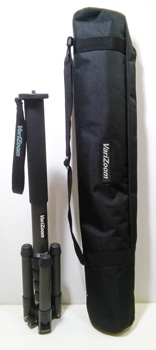 |
The
VariZoom
Chicken Foot
Carbon Fiber Monopod
with included bag |
My
wife uses our Feisol CM-1471 carbon fiber monopod more than
I do, and was curious whether a stabilizing foot would help
her control the camera better. Initially I had planned to only
purchase a stabilizing foot attachment for our Feisol. I found
the 3 Legged Thing DOCZ2 Foot Stabilizer, which appeared to
be a solution. However, when I examined the Feisol monopod,
there was no way to attach the DOCZ2's standard 3/8-16 threaded
foot to the Feisol. Under the Feisol's rubber cap foot was a
threaded hole that my little finger would fit into, approximately
9/16 diameter. While the Feisol is a fine little monopod, with
which we have been quite satisfied, there was no way I could
attach the DOCZ2 foot. Apparently the Feisol's non-standard
hole would not work with anybody's replacement foot or attachment
of any kind. So I switched gears and looked at monopods with
a stabilizing foot already attached. I finally chose the VariZoom
"Chicken Foot" monopod.
 |
Three
heavy duty spikes are included
that interchange with the rubber tips |
While
the name sounds a bit humorous ... "Chicken Foot"...,
it does grab your attention, and aptly describes the small "tripod"
at the base of the VariZoom monopod when spread out nearly flat.
When not folded up against the monopod for storage and transport,
the tripod-like stabilizer feet on this monopod click out and
down in three steps, at 3 angles, much like full-sized tripod
legs commonly adjust. With a distinct click they snap firmly
into each position. Pressing a button on each "leg"
releases them for angle adjustment or to fold up inverted out
of the way for storage. It feels very familiar and assuring
after using tripods with similar mechanisms. I did find, though,
that while the tripod feet seem sturdily made, they do exhibit
some flex under the weight of a Canon 7D body with 100-400mm
f/4.5-5.6 L zoom lens and gimbal head (a little over 6 poounds)
when set to their near 90° angle (nearly flat). At 45°
the flex is negligible, but the stance isn't as wide.
The VariZoom
monopod's tripod stabilizer legs come tipped with standard 3/8-16
threaded rubber tips attached. These rubber
tips can be unscrewed and swapped out with three included,
very sturdy spiked tips. The monopod also comes with an extra
rubber foot tip with 3/8-16 threaded stud, though it is larger
and shaped differently from the others, and is not mentioned
in the single sheet page of instructions. I assumed it must
be an optional tip for the monopod base, which implied the stabilizer
base would unscrew, though, again, there is no mention of this
fact either in the instructions.
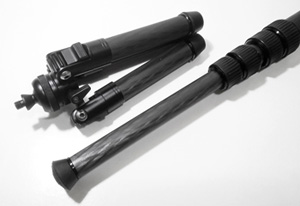 |
 |
The
VariZoom's stabilizer foot can be
unscrewed and replaced with the included
rubber tip to convert the Chicken Foot into
a standard single tipped monopod |
Stabilizer
foot screws into end plug,
but end plug spins in leg
|
 |
The
"Chicken Foot"
stabilizer legs at their
nearly 90° angle setting |
|
Initially
I found that the "chicken foot" stabilizer base would
indeed unscrew, and the extra rubber tip would screw in, transforming
the monopod into a standard single
point tipped support. However, when I later tried to duplicate
this change-out of the tripod stabilizer legs with the single
rubber tip, I found that the metal insert in the lower leg section
was now spinning around, not allowing me to unscrew the tripod
foot. That was not a good sign. But by gripping the metal insert's
edge with pliers (protected from the plier's teeth by a soft
insert) I was again able to unscrew the tripod tip, screw in
the rubber foot, and then screw the tripod legs back on again.
This left me wondering whether or not the tripod stabilizer
base was supposed to be removable at all. But if not, then what
was the purpose of the single extra screw-in rubber tip? To
resolve this I contacted VariZoom for answers.
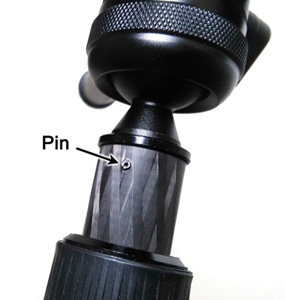 |
The
replacement monopod had the pin
installed, but the end plug would
still spin around when it should not. |
VariZoom said
the stabilizer was indeed supposed to be interchangeable with
the rubber foot. After I explained the slippage issue several
times, they finally grasped what I was talking about and asked
me to send photos of the lower end of the monopod. The photos
confirmed there was a missing pin that should have locked the
end plug from spinning around. They shipped me a replacement
monopod, at no cost to me, which arrived 7 days later, and told
me to keep the original one. So now I had two identical monopods.
The good news is that the new monopod had the pin. The bad news
is that the pin didn't help at all. The plug in the new monopod
would spin around exactly as the first one did when I tried
to snug the stabilizing base into the threaded hole so that
it wouldn't come unscrewed and fall off with normal handling.
Additionally, I eventually realized the pin in the new monopod
was not flush with the carbon fiber leg surface. It was raised
about 1mm. The leg lock would bump the pin when closing down
the bottom leg section, causing concern it might damage the
inner lock rings under the leg lock grip. This is clearly a
design and manufacturing issue that needs to be remedied. I
finally had to carefully file down the pin so it was flush with
the leg to avoid damaging the locking rings.
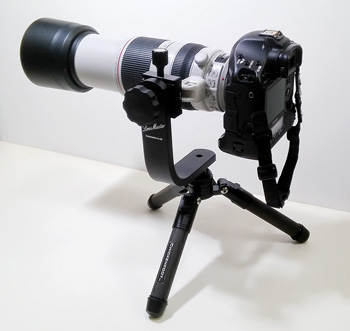 |
Add
a gimbal head to the VariZoom's stabilizer
foot and it can serve as a mini-tripod for tabletop
or low angle shooting. Set it in an old frying
pan and you have a suitable ground pod.
|
The Chicken
Foot stabilizer base is mounted to the monopod via what is essentially
a ball head. This allows the monopod shaft to tilt in any direction
while keeping the tripod feet flat on the ground. It also allows
the monopod to spin around for panning. A knob on the ball base
provides adjustment of the ball tension. And
herein lies the problem. In order for the monopod to
rotate and pan the camera, the stabilizer foot's ball joint
base cannot be too tight. But when the ball joint base is tensioned
just enough so the monopod tends to stay upright, yet still
allows it to lean or rotate when you follow a subject, the foot
starts to unscrew from the monopod, which is not supposed to
happen. If the foot is screwed tightly into the monopod end
so it won't easily unscrew, the end plug spins in the monopod
leg, and that also is not supposed to happen. If you ignored
this problem, it would eventually become sloppy loose and just
fall out altogether. The end plug must be locked in place inside
the monopod lower section for it to work correctly, and that
is not happening. The pin that is supposed to hold it fails
to do so. It is a basic design flaw in an otherwise good idea.
 |
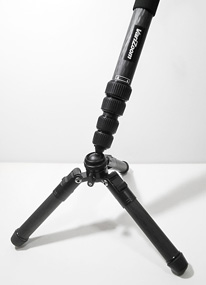 |
| The
Stabilizier base has a ball joint for tilt and rotation. |
So, how do you remedy this? (A)
Return the Chicken Foot and get a different monopod. Maybe you'll
have better luck with it. (B) Drill your own holes in
the leg and put self-tapping screws into the end plug hoping
it will stop it from spinning. (C) Use a head that has
it's own rotating collar as required for a tripod. After all,
this IS essentiallly a tall, skinny tripod, with three legs,
albeit they are short indeed. In order to stabilize like a tripod,
the ball joint needs to be snug so the monopod wants to stand
up straight. Otherwise, the tripod feet on it serve no purpose.
One benefit
of the Chicken Foot base is that it can serve as a quite sturdy
tabletop
tripod by adding a gimbal head. In the photo above it is
supporting a Canon 100-400 f/4 vII zoom with a 1D Mark 4 pro
body. You can put this setup in an old frying pan and have a
fully functional ground pod support for those birds on the beach.
The leg
locks on the 5-sectioned shaft are twist lock tension rings,
which work smoothly, lock firmly and easily, and unlock without
fighting them. They actually work more smoothly and easily than
the locks on either of my Gitzo tripods. The carbon fiber sections
look to be of quality, and the overall fit and finish of the
VariZoom seems high quality as well. This 5-section monopod
extends to about 73 inches (6 feet 1 inch) with the stabilizer
legs flat out, and 79 inches with the tripod legs angled sharply
down. Add to that your head of choice, and your camera is mounted
well above most anyone's eye level, which is more than enough
height for most any practical application I can imagine. Closed
down to its shortest length with the base legs folded up the
VariZoom measures a petite 20.75 inches (an inch shorter than
my Fiesol CM-1471).
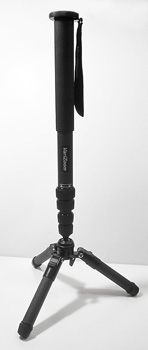 |
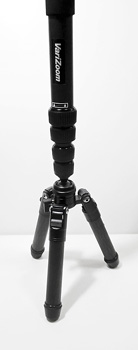 |
The
VariZoom
Chicken Foot
Carbon Fiber Monopod
with legs set at
45° angle |
The
"Chicken Foot"
with legs at their
tallest angle |
 |
 |
With
my gimbal screwed on
snuggly, the locking studs ended
up straddling the gimbal bar and
could not lock it in place |
By
rotating the 6-sided "nut" on the
reversible head mounting stud, the
thread's starting point shifts so the
gimbal will line up over the locking studs |
| |
|
The monopod's
top plate can be unscrewed in order to invert the head mounting
stud, with 3/8-16 threads on one end and 1/4-20 threads on the
other. The top plate has two locking studs (with Allen wrench
provided) to lock your head in position on the top plate. It
just so happened in my case that when I screwed down my gimbal
head on the monopod tightly, the two locking studs were positioned
to either
side of the gimbal base so that neither stud would lock
the gimbal from unscrewing. This threw me for a bit wondering
how I was to lock the gimbal in position. But when I took the
head plate off the monopod to see how the stud inverted from
3/8-16 to 1/4-20 threads, I realized I could solve the issue
by rotating
the stud's 6-sided "nut" a little in the hole.
This rotated the gimbal's thread starting point a little farther
around so the locking studs fell under the gimbal base. Now
I could tighten the locking studs against the gimbal base properly.
The nicely
made, sturdy, zippered bag/case that comes with the VariZoom
has a fully zippered 15"x4" pocket inside to hold
your extra rubber tip, Allen wrench, optional spike tips and
more. I was very pleased to discover that
the bag is long enough to hold the monopod with my LensMaster
T-1 gimbal head attached, and it fits perfectly. That not
only saved me from having to make a padded cover for the gimbal
head, it makes packing, storing and transporting much simpler.
Conclusions:
If you are looking
to use the VariZoom Chicken Foot for any non-action style photography
that uses short lens, like landscape, it should work out well.
I am confident that VariZoom designed the Chicken Foot mainly
for small camera video use, and I think it would work well for
that too. But in my photo world mostly of birds and wild horses
at Carolina Wild Photo, action is the name of
the game, with long and heavy lenses. To gain full benefit of
the larger stabilizing footprint it provides, the ball base
needs to be locked to keep the monopod upright, but that means
you loose the normal rotation/panning of the standard monopod
point pivoting action. If you loosen the ball base to gain pivoting,
you loose the vertical stability of the wider footprint. So
you will have to treat it like a tripod and use a gimbal head
with a rotating bearing. Of course, you should never attempt
to leave this monopod to stand on it's own without some kind
of grip on it, just in case.
Overall
I like the Chicken Foot. My only real beef is with the design
failure and manufacturing quality where the end plug is concerned.
VariZoom knew there was a problem with the pin when they sent
me a replacement, and yet it arrived with the same pin problem.
It would seem they did not bother to test it and check it out
before shipping. Their customer service would seem above par.
After all, they did replace the unit, at no cost to me, without
even wanting the original unit returned at all. But in the end,
two new monopods with the same problem didn't resolve anything.
It only seemed to confirm a lack of concern with fixing the
underlying problem.
Unaware
the monopod would have this panning issue, I had ordered a monopod
gimbal when I ordered the Chicken Foot, which would seem to
make sense. The monopod gimbal has no rotating collar for panning,
since normally the monopod pivots to provide panning. So, in
the end I had to order another gimbal with a rotating collar.
I chose another LensMaster gimbal, the T-1 Traveller, making
it my fourth LensMaster gimbal. Though this review is not about
LensMasters gimbals, the fact that I've added a 4th LensMaster
gimbal to my collection is a statement as to the supreme sturdiness,
reliability and wonderful affordability of the LensMaster
gimbal line. I've used my original LensMaster
RH-2 full gimbal for six years now, mounted to a Gitzo GT5541LS
tripod. Additionally, I've used LensMaster's
RH-1 gimbal on a Gitzo G1348 Mk2 tripod, and LensMaster's
M-1 gimbal on a Feisol CM-1471 Monopod for over four years.
|
|
 |
|
 |
